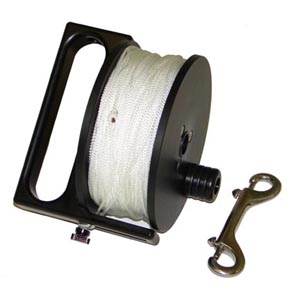Okay, since you won't take "NO" for an answer...... :blinking:
First you have to have a reel before you can practice.
I recommend a finger spool for your emergency "reel" with ~50-100 feet of cave line. There's nothing worse than have a reel jam when you're lights are out and you've lost the main line. A spool never jams, but it can be dropped.
Ok, so we're making a distinction between a finger spool and a reel, right?
Finger spool is for backup, right?
Underwater, practice tying off the line and running out line, then reeling it back it. You don't need tie offs with a spool.
Why don't I need tie-offs with a spool?
This is just to get used to handling a spool without fumbling it. The spool should be stowed in one of your pockets.
Unrelated question but I just got a BP/W and a leg mounted pocket. I hate the leg pocket, more than one heavy thing in there does not help retrieval - any other good options out there for stowing?
Also practice removing and stowing the spool without looking down at your pocket. When you look down at your pocket, your trim is thrown off.
I don't need to look at any of my rig to use it
Next you need a reel. In cavern, you're going to need a reel to establish a line from open water to the cavern line.
this will seem like a stupid question but are you saying that once into the cavern there is existing line to use/hook into? And that my line will be used to getting me as far as the existing/permanent line?
It doesn't need to be 400 feet long, 150-200 feet is fine.
Reel selection is a personal thing. Having had to repeatedly deal with jammed line with a standard overhand reel (of course, all jams are caused by user errors), I prefer side reels now. I really like the smooth Salvo reels, they must have ball-bearings and are works of art. I think Halcyon reels are similar in quality.
Thanks for the tips - I'll check out both. I haven't bought new kit for a couple of days so I'm starting to get withdrawals anyhow...
(Be careful how you attached the double ender to the reel. If you attach it one way, it can lever off easily. If you attach it the other way, it can't.)
[-]You lost me on the statement above. What's a double ender?[/-]
Ok, so a double ender is a bolt snap. Ish.
The hard part of reel is holding it in your left hand hand along with your light. You've got to keep a finger on the reel at all times to keep tension on the line. If you let the reel freely spin, it will do so and spit out a lot of line in a big tangle.
Good point. Are there any good reasons not to velcro your light to your forearm so that you do not require any fingers to control it?
Underwater, practice laying line with your light and reel in your left hand, keeping tension on the line at all times.
Will do, once I get my reel
The second skill to learn is being able to hover long enough in order to make a tie off. You don't want to be grabbing onto the rock to stabilize yourself while you make the tie off. You want to swim up to the tie off point, stop your forward momentum with a bit of a back kick, hover, and tie off without grabbing onto things or sweeping your hands.
Wow, great, somethings I can do! I'm pretty ok with buoyancy trim and different kicks (including back kick although it's not going to win any awards anytime soon). I never ever use my hands.
Enough material to work on?







